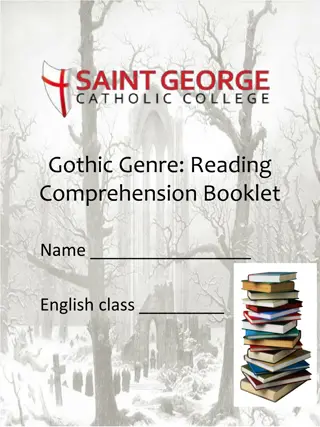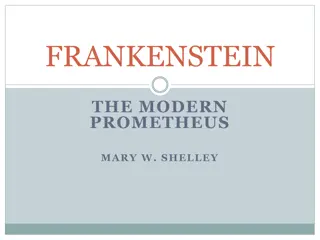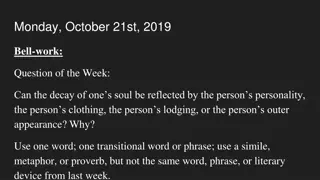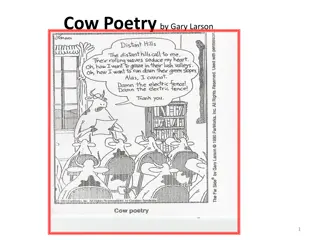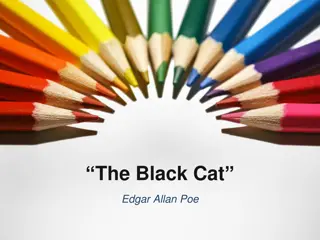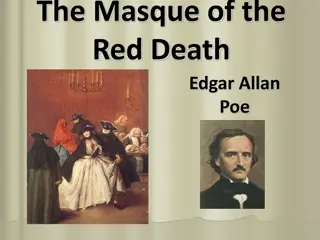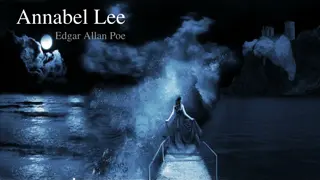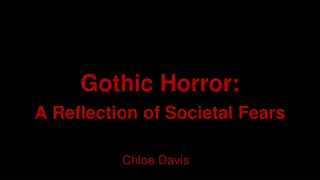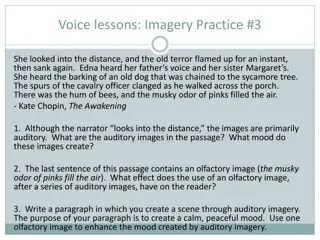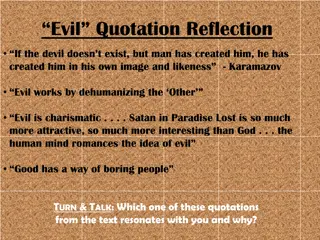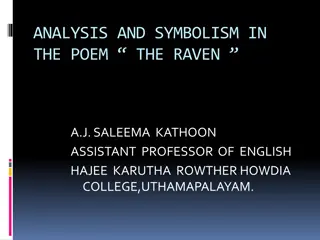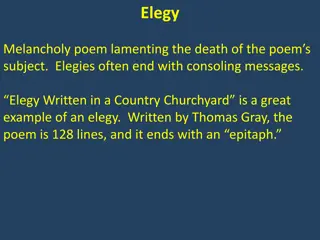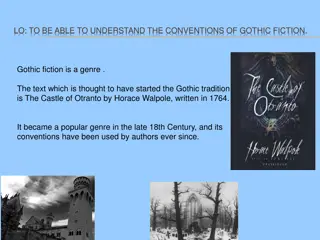Gothic Literature and Edgar Allan Poe: A Deep Dive into the Dark and Mysterious
Delve into the world of Gothic literature through the works of Edgar Allan Poe, a master of the genre. Explore the eerie settings, melodramatic narratives, and sense of fear and dread that define Gothic literature. Discover Poe's life story, his struggles, and his enigmatic persona that still intrigues readers today. Unveil the supernatural elements and psychological depth in Poe's writing that set him apart as a unique voice in the Gothic Romantic period.
Download Presentation

Please find below an Image/Link to download the presentation.
The content on the website is provided AS IS for your information and personal use only. It may not be sold, licensed, or shared on other websites without obtaining consent from the author. Download presentation by click this link. If you encounter any issues during the download, it is possible that the publisher has removed the file from their server.
E N D
Presentation Transcript
The fall of the House of Usher (1839) By Edgar Allan Poe
Short Biography of Poe Born in Boston in 1809 to Elizabeth Arnold Poe and David Poe. His father abandoned them while he was a child. After his mother s death Poe and his brother and sister were adopted. Poe was taken by John Allan, a successful merchant. He attended the University of Virginia and did very well in Latin and French, but because of his gambling debts he had to drop out college. Due to fights with his foster father, he went to Boston where he wrote his first poetry book, Tamerlane and Other Poems. In an attempt to support himself, he enlisted in the army.
Realizing that his passion is about writing, he left the army and went to Baltimore to live with his poor aunt and her daughter. He later married his cousin. He wrote many works and become an editor of the Graham magazine. On october 7, 1849, while in Baltimore, Poe died at the age of 40. There are many mysteries concerning Poe s death. It has been attributed to acute congestion of the brain and drug and alcohol overdoses. Edgar Allan Poe probably remains, both in his life and in his work, America s most controversial writer. Numerous biographical and critical studies did not succeed in rectifying the initially distorted myth of Poe as a self- destructive, alcoholic, almost demoniac creature. Even today, after much serious research and analysis, the true Poe remains enigmatic and elusive. The same is true of his works.
Gothic literature Gothic literature is as writing that employs: dark and picturesque scenery startling and melodramatic narrative devices an overall atmosphere of exoticism, mystery, fear, and dread.
Gothic Romantic period in Britain. the first mention of "Gothic was in the subtitle of Horace Walpole's 1765 story "The Castle of Otranto: A Gothic Story" which, the British Library says, was meant by the author as a subtle joke. "When he used the word it meant something like barbarous, as well as deriving from the Middle Ages. " literature developed during the
The supernatural elements in stories were captured by America's Edgar Allen Poe in the mid-1800s and succeeded like no one else. In Gothic literature, he found a place to explore psychological trauma, the evils of man, and mental illness.
Elements of Gothic Writing Emphasis on setting -Exterior: landscape -Enterior: houses Castle like architecture characters are brooding and secretive Buried family secrets Long history of a family tied to a place
The Fall of the House of Usher The most famous short story of Edgar Allan Poe It is the masterpiece of American Gothic Fiction. Gothic fiction: dark, strange, and melodramic stories which lead to something evil.
Gothic Fiction Features Horror The Supernatural Death Madness Hereditary Curses Medieval-like settings
Historical Context Precisely where and when "The Fall of the House of Usher" occurs is impossible to determine, as readers are given few geographical or temporal markers. Like many of Poe's tales, its setting is somewhat dream-like and universal. Roderick's apparent anxiety that Madeline's doctors will disinter and study her corpse suggests that the story might be set in the first decades of the 1800s, as this period "saw a proliferation of medical schools and a concurrent explosion in demand for cadavers" (Tward). The story's references not only to the medieval in general but to the Gothic in particular are significant, for the term "Gothic" refers to an architectural style common in the Middle Ages that enjoyed renewed popularity during the nineteenth century in both design and literature.
Societal context Having lived in Virginia and South Carolina, Poe was quite familiar with southern society and culture. Moreover, a magazine he edited, the "Southern Literary Messenger," published pieces that both affirmed and questioned the "peculiar institution" of slavery. Accordingly, some critics have argued that "The Fall of the House of Usher" describes the decline and fall of the American South. If we view "The Fall of the House of Usher" as an allegory for the South's demise, it is worth considering the bond between mistress and slave as represented by Madeline and Roderick. While there are no actual slaves in the tale, the narrator does metaphorically describe Roderick as "a bounden slave" to "an anomalous species of terror" (95)-namely, that he will die of fright. Ultimately, Roderick's deadly fear is Madeline; thus, figuratively speaking, Roderick is a slave and Madeline is his mistress. Moreover, their relationship is characterized by "sympathies of a scarcely intelligible nature" (102) similar to those Poe attributed to the mutually dependent relationship between master and slave. That said, the fact that Madeline falls upon Roderick and kills him-after he has buried and tried to destroy her-might suggest that the South will ultimately collapse under the burden of slavery.
Main characters The narrator: a friend of the master of the House of Usher. He is summoned to try to cheer up Usher but is himself becomes fearful and nervously excited by the gloomy atmosphere of the Usher home. He witnesses terrifying events. Roderick Usher: the master of the house. He suffers from a depressing malaise. Roderick Usher, a madman. Excessively reserved in childhood and thereafter, Usher is the victim not only of his own introversion but also of the dry rot in his family, which because of inbreeding has long lacked the healthy infusion of vigorous blood from other families. Madeline Usher: twin sister of Roderick. She also suffers from a strange ilness.
Point of view First person A nameless narrator who describes the events as he sees them
The story The narrator arrives to the Usher s house; an old mansion encircled by a small tarn (lake). A bridge across the tarn provides access to the house. Roderick lives there with his twin sister who is near death due to a mysterious illness. The narrator stays with them. He provides company to Roderick while he paints and plays guitar. He spends all his day inside avoiding daylight.
When Madeline dies, her brother decides to bury her temporarily in one of the house s large vaults. A few days later, during a stormy night, the narrator could not sleep because he was terrified. Roderick comes to the narrator s bedroom. The narrator attempts to calm Roderick by reading The Mad Trist , a story about a knight named Ethelred who slays a dragon and wins a shield of shinning brass.
While the narrator reads the story, both he and Roderick hear the same weird sounds. It is at that moment that Roderick confesses that Madeline was alive when he buried her. All of a sudden, Madeline emerges from her provisional tomb, confronts Roderick, and starts throttling him to death. Ultimately, the house starts to collapse. The narrator flees for his life. Roderick is dead. He and Madeline are consumed by the falling house.
Structure and Unity Poe creates texts within texts 1. The Haunted Palace a poem that reflects the Usher family life in the house 2. The Mad Trist a story that parralels Madeleine s return from the grave
Focus Ilness Madness Incest
Symbolism A tarn encircling the Mansion and reflecting its image: Madeline as the twin of Roderick, reflecting his image and personality The desire of the Ushers to isolate themselves from the outside world. The bridge over the tarn: the narrator as Roderick s only link to the outside world. The name Usher: An Usher is a doorkeeper. In this sense, Roderick opens the door to a frightening world for the narrator The storm: the turbulent emotions experienced by the characters The collapsing Mansion: fall of the Usher family
Symbols The House: Just as the house is ancient and upon the verge of collapse, so too is the family. The title thus describes the literal fall or dissolution of the mansion and the demise of the Usher family, as Roderick and Madeline are the last of their line. It is appropriate that the story's action takes place "in the autumn of the year" (90) (that is, in the fall), and that everywhere are images decomposition of death and
Function of the house The house of Usher has two meanings 1. the physical dwelling 2. the family line, or lineage The landscape is overgrown and ragged. On the front down the middle is a barely perceptible fissure going in a zigzag direction
The interior setting of the house Gothic architecture windows were long, narrow and pointed feeble gleams of encrimsoned light dark draperies atmosphere of sorrow Roderick lives upstairs (mind) Madeline is buried below ground (body)
The Doubling Motif In literary Criticism, this the is German called a doppelganger double- goer It represents the dual nature of man. In Poe, one side of man is reason, or the mind. The other is the body. Roderick and Madeline are genetically twins, but they are also psychologically doubles. from for
Who represents what? Roderick -an artist figure -Nervous agitation - lives in a dark upstairs apartment -Cadaverous complexion -want of moral energy
His environment he was enchanted by certains supersitious impressions in regard to the dwelling which he tenanted An effect with the physique of the gray walls and turrets, and of the dim tarn into which they all looked down, had, at length, brought about upon the morale of his existence -Here, physique refers to something physical and moral refers to something mental. Roderick is all mind in a weak body He represents in one way the life of the isolated artist (painting, reading, guitar playing) mental condition is affected by his
Madeline All descriptions focus on the body - gradual wasting of away of the person She returns from the tomb to reclaim her twin brother, her double she fell heavily inward upon her brother and bore him to the floor a corpse
What is Poes point Poe adresses the dual and conflicted nature of the self. Mind and body are at war with each other in each of us We try to repress one side and live without it, but we cannot achieve a harmonious existence in this way.
Diverse Readings In the first psychological approach, the analysis focuses on the unreliable narrator as he chronicles Roderick madness. As an artist, intellectual, and introvert, Usher becomes so lopsided that his prolonged isolation, coupled with the sickness of his sister, drives him to the edge of madness; along with the narrator, the reader sees him go over the edge. Another possibility is that the tale is simply a detective story; Usher manipulates the narrator into helping him murder Madeline and then goes insane. Usher s descent into
According to the second general view, the actions of the characters can be explained only by postulating a supernatural agency: The Usher curse is working itself out; the house is possessed and is destroying the occupants; Roderick is a demon drawing vitality from his sister until, as a nemesis figure, she returns to punish him
In the third view, the story is seen as an allegory: Roderick as intellect is suppressing sensuality (Madeline) until it revolts. Roderick is the artist who must destroy himself (his other self incarnated in his sister) in order to create.




